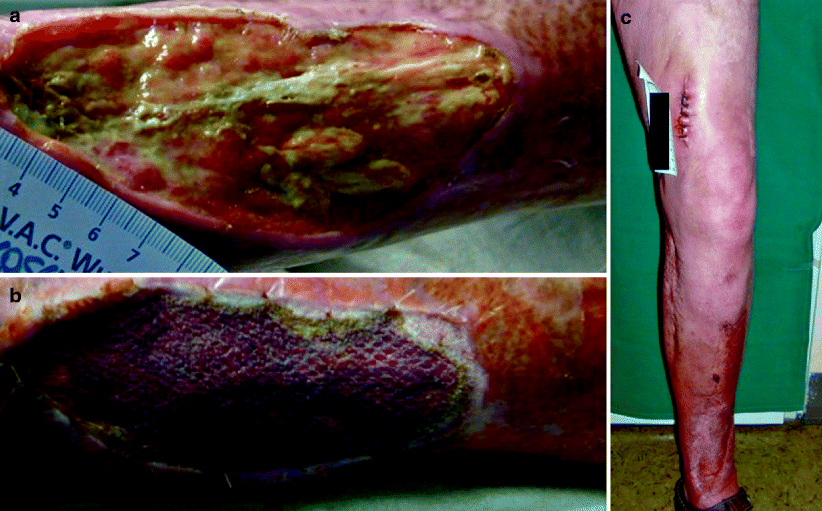Fig. 16.1
Pre- and postoperative angiogram of a patient undergoing arterial transplantation. The patient had undergone eight pervious vascular procedures on the left leg after varicose vein surgery 35 years ago. Panel a shows distal runoff via the posterior tibial artery. Panel b shows a postoperative follow-up angiogram 2 years after the procedure with moderate aneurysmal degeneration of the graft
Frequency
Fresh arterial homograft implantation is an infrequent procedure. We are trying hard to follow an all autologous vein bypass policy, and about 95 % of all infrainguinal bypass procedures are performed with autologous vein. The remainder of the bypass procedures comprises bridge grafts, and only 1.5 % of all infrainguinal bypass procedures are performed with arterial homografts. This is not because of a shortage of these grafts. Austria has very liberal organ donation legislation in which every patient experiencing irreversible brain death may become a potential organ donor. Despite increasing donor age, the average waiting time for a fresh arterial homograft is 2 weeks. This procedure, although not entirely experimental, is reserved for patients in whom no other option is available (Fig. 16.2) or who are under immunosuppressive therapy for a solid organ transplant.


Fig. 16.2
Pre.- and postoperative view of the same patient as shown in Fig. 16.1. Panel a: Extensive gangrene on the anterior aspect of the calf prevented artificial graft use. Patient was MRSA positive. Panel b: After revascularization, debridement, and vacuum therapy, a split thickness skin graft heals nicely. Panel c: The lesion is completely healed 3 years after the procedure, and the patient is essentially symptom free. Nevertheless, occasional thrombectomies are necessary to maintain graft function
Conclusion
Fresh arterial homograft for distal bypass with moderate immunosuppressive therapy seems to be a promising way to go in selected patients with distal arterial disease who are difficult to manage. It is unclear whether fresh or cryopreserved homografts are the way to go or if arterial or venous homografts perform better. Careful graft procurement by surgeons with vascular surgery experience is of great advantage. Patient and donor selection together with careful follow-up is a key for success in these patients and will lead to gratifying results [18, 19, 22, 28, 30].
References
1.
2.
3.
4.
5.
6.
Chew DK, Owens CD, Belkin M, Donaldson MC, Whittemore AD, Mannick JA, et al. Bypass in the absence of ispilateral greater saphenous vein: safety and superiority of the contralateral saphenous vein. J Vasc Surg. 2002;35:1085–92.PubMedCrossRef
< div class='tao-gold-member'>
Only gold members can continue reading. Log In or Register to continue
Stay updated, free articles. Join our Telegram channel

Full access? Get Clinical Tree


